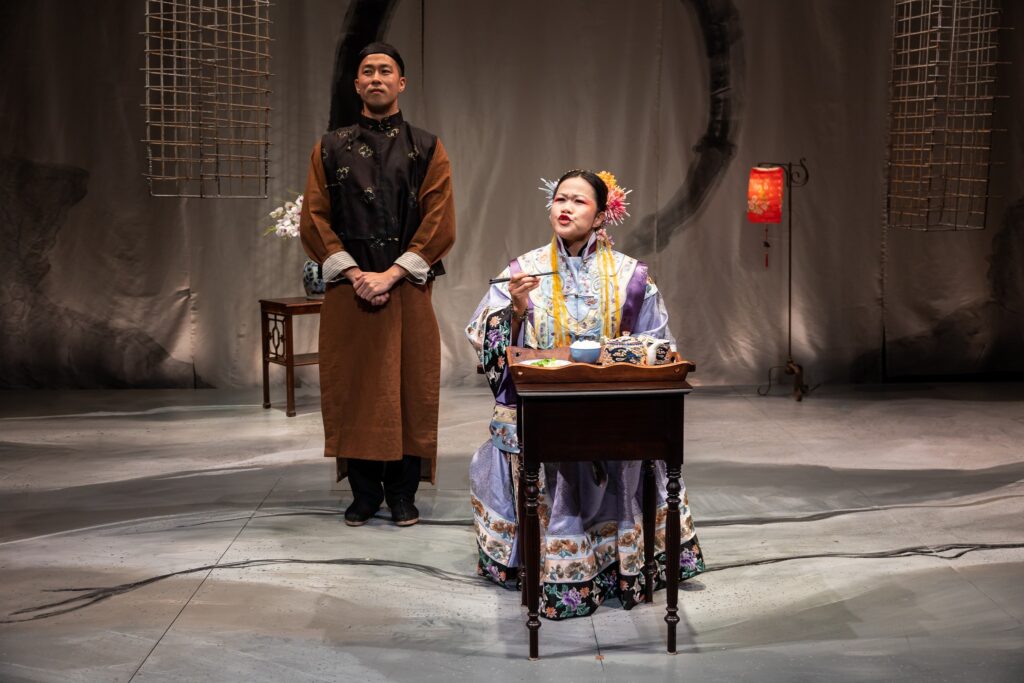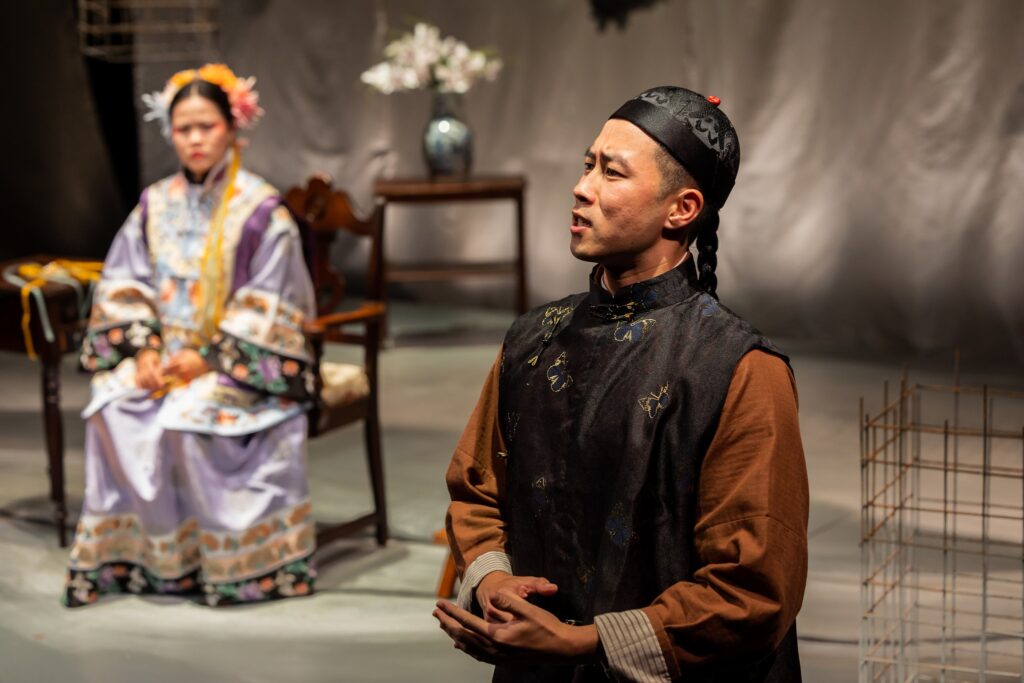
Written by Lloyd Suh. Directed by Sarah Shin. Set Design by Qingan Zhang. Lighting Design by Kat C. Zhou. Costume Design by Sandra Zhihan Jia. Sound Design by Kai Bohlman. Presented in partnership with CHUANG Stage at Central Square Theater, Cambridge through December 11, 2022.
by Linda Chin
In November 1834, fresh off the boat from Guangdong, China, fourteen-year-old Afong Moy made her New York City debut. Brought to the U.S. by New England merchants Nathaniel and Frederick Carne, Moy was featured in an exhibit the Carnes created to promote their trade goods from the exotic East. In a full-size diorama filled with Chinese paintings, lanterns, vases, and other (inanimate) decorative objects, a Chinese Lady (Moy) in full theatrical makeup, elaborately embroidered silk clothing and seated in an ornamental chair was also on display. She demonstrated how one skillfully eats with chopsticks, properly pours and drinks tea, and walks gracefully in lotus shoes adorning her four-inch feet. A brief audience Q&A facilitated by interpreter Atung followed the performance. Confined in a box for eight hours a day, Moy diligently carried out her role of cultural ambassador, repeating her act over and over again for the “education and entertainment” of an estimated 2000 audience members/week.
The agreement the traders negotiated with Moy’s parents promised her return in two years, but high demand for both their imported goods and show tickets (even after they doubled the price from 25 to 50 cents) promised them a better return. The Carnes toured their chattels (Moy + Atung) to venues across the U.S., including Boston’s now defunct Chinese Museum, for well over a decade. Moy’s travels were covered in newspapers: in the nation’s capital the “unprecedented novelty” met with President Andrew Jackson; in Philadelphia, physicians examined and verified the length of her feet; and in Charleston, her unwrapped feet were on public display. How Moy or the public perceived – or felt about – her extended stay, or her shift from cultural ambassador to spectacle, is unclear. When P.T. Barnum’s put her in his menagerie of freaks in 1848 and replaced her with a younger “Chinese Lady” two years later, Moy’s identity as an object of curiosity and revulsion was likely not lost on her. Accounts of her whereabouts essentially vanished in 1850 to this day, her contributions to Asian American history – and American history – are largely unknown.

As the daughter of immigrants from Guangdong, born, raised and educated in the U.S., I too was unfamiliar with Afong Moy until a few years ago. Though American history tried to erase her story, it has been beautifully captured by acclaimed American playwright Lloyd Suh’s in his newest work, The Chinese Lady. Suh, a Korean American man originally from Indianapolis, has boldly reassembled “facts” about the first recognized Chinese woman in America – snippets of information documented through the eyes of others – into a self-portrait of Afong Moy that infuses her feelings, thoughts, and perspectives. In the 2021-22 season, The Chinese Lady was the most produced play in America, and is still reaching audiences far and wide. And nearly two centuries after she arrived in America (and Boston), thousands more community members have the opportunity to be introduced to Afong Moy at Central Square Theater, which is producing The Chinese Lady in partnership with CHUANG Stage.
The CST-CHUANG version of The Chinese Lady educates and entertains, and puts the talents of Asian American theatre artists on display. In the first few minutes of the 90 minute play, Afong Moy (portrayed with elegance and poignancy by Sophori Ngin) urges the audience to dissociate the performance they are seeing on stage and reality. Her words have been scripted, the clothing not of her own choosing, the Room she is in “unlike any room in China. Just as I am intended to be representative of The Chinese Lady: the first woman from the Orient to ever set foot in America…I am unlike any lady to ever live.” She is not referring to author Lloyd Suh, costume designer Sandra Zhihan Jia, set designer Qingan Zhang, or director Sarah Shin, who have done an extraordinary job casting this production and designing the world of this play. Rather she places the responsibility on the Carnes, her capitalistic captors, P.T. Barnum, creator of the “circus of exploitation,” and people in positions of power, like the President of the United States. For the latter, she is foreshadowing a meeting with President Andrew Jackson (brilliantly portrayed by Woo) which occurs later in the play. He displays behavior unbefitting of someone of his stature – he strokes her feet and calls them “disgusting and mesmerizing.” Woo also plays her interpreter/assistant Atung, who is present at this 1:1 private meeting. His transitions between the revolting bombastic ruler and respectful humble translator are magnificent. Lest anyone make any comparisons to contemporary America, Suh (who penned this play in 2018) may have been prophetic of a different dialogue, where Moy, who addresses the President as “Your First Emperor,” is given a nickname like Ah-Fong of Grand-Dong.
Both Ngin and Woo are delightfully expressive and are accomplished physical actors. Ngin’s riff on using chopsticks and slurping tea elicited many laughs. The looks of disgust on Moy’s face during the scene with Jackson speak 1000 words that do not need translation by Atung. Similarly, if Atung was positioned more on-stage level in many scenes, instead of down front below, we wouldn’t miss Woo’s (always in character) wonderful facial expressions. Moy shows Ngin’s dance experience with beautiful control of her arms and hands, but walked more quickly, with larger steps, than I would have expected for someone with bound feet. In terms of the set, I would have preferred that it felt more claustrophobic than open and airy, that the backdrops were a different color than white (which is the color associated with mourning and death in Chinese culture). These observations did not detract from audience members’ appreciation of the show.
With the long history of anti-Asian hate in the United States, and the parallel pandemics of COVID-19 and systemic racism, producing a play as essential as The Chinese Lady is no small feat. Kudos to the partnership between Central Square Theater and CHUANG Stage, helmed respectively and respectfully by Artistic Director Lee Mikeska Gardner and Co-Founder and Executive Producer Alison Yueming Qu (also the play’s dramaturg). This team has done Afong Moy proud. For tickets and information, go to: https://www.centralsquaretheater.org/

